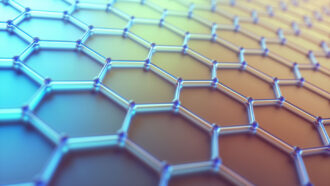Sunflower-like rods could boost efficiency of solar collectors
They keep bending toward the sun, then stopping when poised to soak up maximum energy

Rods of a new solar-energy-collection material seen at front of this drawing were inspired by sunflowers.
Yusen Zhao, Yousif Alsaid and Ximin He
By Sofie Bates
The stems of sunflowers move throughout the day so that their flowery heads always squarely face the sun, wherever it is in the sky. This phototropism (Foh-toh-TROAP-ism) helps the plants soak up maximum amounts of sunlight. Scientists had trouble copying this ability with synthetic materials. Until now.
Researchers at the University of California, Los Angeles have just developed a material with the same type of sun-tracking ability. They describe it as the first synthetic phototropic material.
When shaped into rods, their so-called SunBOTs can move and bend like mini sunflower stems. This allows them to capture about 90 percent of the sun’s available light energy (when the sun is shining on them at a 75-degree angle). That’s more than triple the energy collection of today’s best solar systems.
People have often been inspired by the world around them. Scientists, too, may look to plants and animals for clues to new discoveries. Ximin He is a materials scientist. She and her team found the idea for their new material in sunflowers.
Other scientists have made substances that can bend toward light. But those materials stop at a random spot. They don’t move into the best position to catch the sun’s rays and then stay there until it’s time to move again. The new SunBOTs do. The whole process happens almost at once.
In tests, the scientists pointed light at the rods from different angles and from a range of directions. They also used different light sources, such as a laser pointer and a machine that simulates sunlight. No matter what they did, the SunBOTs followed the light. They bent toward the light, then stopped when the light stopped moving — all on their own.
On November 4, they described how these SunBOTs work in Nature Nanotechnology.
How SunBOTs are made
SunBOTs are made from two main parts. One is a type of nanomaterial. It’s made from billionth-of-a-meter size pieces of a material that responds to light by heating up. The researchers embedded these nanobits into something known as a polymer. Polymers are materials made from long, bound chains of smaller chemicals. The polymer that He’s team chose shrinks as it heats up. Together, the polymer and nanobits form a rod. You might think of it as being something like a cylinder of solid glitter glue.
When He’s team beamed light on one of these rods, the side facing the light heated and contracted. This bent the rod toward the beam of light. Once the top of the rod pointed directly at the light, its underside cooled and the bending stopped.
He’s team made its first version of the SunBOT using tiny pieces of gold and a hydrogel — a gel that likes water. But they found that they also could make SunBOTs from many other things. For instance, they substituted tiny pieces of a black material for the gold. And instead of the gel, they used one type of plastic that melts when it gets hot.
This means scientists can now mix and match the two main parts, depending on what they want to use them for. For example, ones made with a hydrogel might work in water. SunBOTs made with the black nanomaterial are less costly than ones made with gold.
This suggests that “scientists can use [SunBOTs] in different environments for different applications,” says Seung-Wuk Lee. He’s a bioengineer at the University of California, Berkeley, who did not work on the SunBOTs.
Little SunBOTs for a sunnier future
UCLA’s He envisions that SunBOTs could be lined up in rows to cover an entire surface, such as a solar panel or window. Such a furry coating would be “like a mini sunflower forest,” she says.
Indeed, coating surfaces with SunBOTs might solve one of the biggest problems in solar energy. While the sun moves across the sky, stationary things — such as a wall or rooftop — don’t. That’s why even today’s best solar panels capture only about 22 percent of the sun’s light. Some solar panels could be pivoted by day to follow the sun. But moving them requires a lot of energy. SunBOTs, in contrast, can move to face the light all on their own — and they don’t need added energy to do it.
By tracking the sun, SunBOTs are able to absorb almost all of the sun’s available light, says Lee, at Berkeley. “That is a major thing that they achieved.”
Ximin He thinks that unmoving solar panels might one day be upgraded by coating their surfaces with a SunBOT forest. By putting the little hairs on top of the panels, “We don’t have to move the solar panel,” she says. “These little hairs will do that job.”
This is one in a series presenting news on technology and innovation, made possible with generous support from the Lemelson Foundation.







